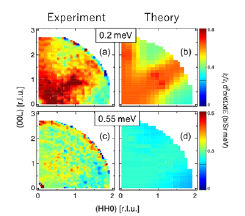Disordered Route to the Coulomb Quantum Spin Liquid: Random Transverse Fields on Spin Ice in Pr2Zr2O7
Nakatsuji Group
As water freezes into ice, ordinal magnets become “solid” (magnetic ordered state), where all the spins are aligned along certain directions, by decreasing temperature. On the other hand, spins are fluctuating like in a liquid state even at very low temperatures in the theoretically predicted exotic state, quantum spin liquid. Pr2Zr2O7 is a rare example of such quantum spin liquids, so-called quantum spin ice, where the 2-in 2-out ice rule is partially melted.

Fig. 1. Inelastic neutron scattering q-map obtained from the experiment at 50 mK for (a) low energy (0.2 meV) region and (c) high energy region (0.55 meV) and the calculation for (b) 0.2 meV and (d) 0.55 meV.
The research groups of Prof. Collin Broholm at Johns Hopkins University and Prof. Satoru Nakatsuji at ISSP have been collaborating on the study of the quantum spin ice material Pr2Zr2O7. The research team has recently performed the inelastic neutron scattering experiments in Pr2Zr2O7 to reveal the origin of the strong quantum fluctuations [1]. The momentum transfer, q, dependent inelastic pattern at low energy region as shown in Fig.1 (a) indicates the spin ice correlations, which is consistent with the previous work [2]. On the other hand, q independent pattern appears at high energy region as shown in Fig.1 (c). The latter was found attributable to the splitting of the non-Kramers ground doublet of Pr3+ due to the crystal disorder. In fact, all of the results are well reproduced by the calculation assuming the classical spin ice in the transverse field coming from the structural disorder, which in fact stabilizes the quantum spin ice state.
It has long been known that the crystal disorder disturbs the spin liquid state by forming a spin glass state. This study causes the stir in this wisdom and provides key information to discover new quantum spin liquid materials, which can lead to the future applications such as quantum computer and spintronic devices using the entangled state of quantum spin ice.
References
- [1] J. -J. Wen, S. M. Koohpayeh, K. A. Ross, B. A. Trump, T. M. McQueen, K. Kimura, S. Nakatsuji, Y. Qiu, D. M. Pajerowski, J. R. D. Copley, and C. L. Broholm, Phys. Rev. Lett. 118, 107206 (2017).
- [2] K. Kimura, S. Nakatsuji, J. -J. Wen, C. Broholm, M. B. Stone, E. Nishibori, and H. Sawa, Nature Communications 4, 1934 (2013).
